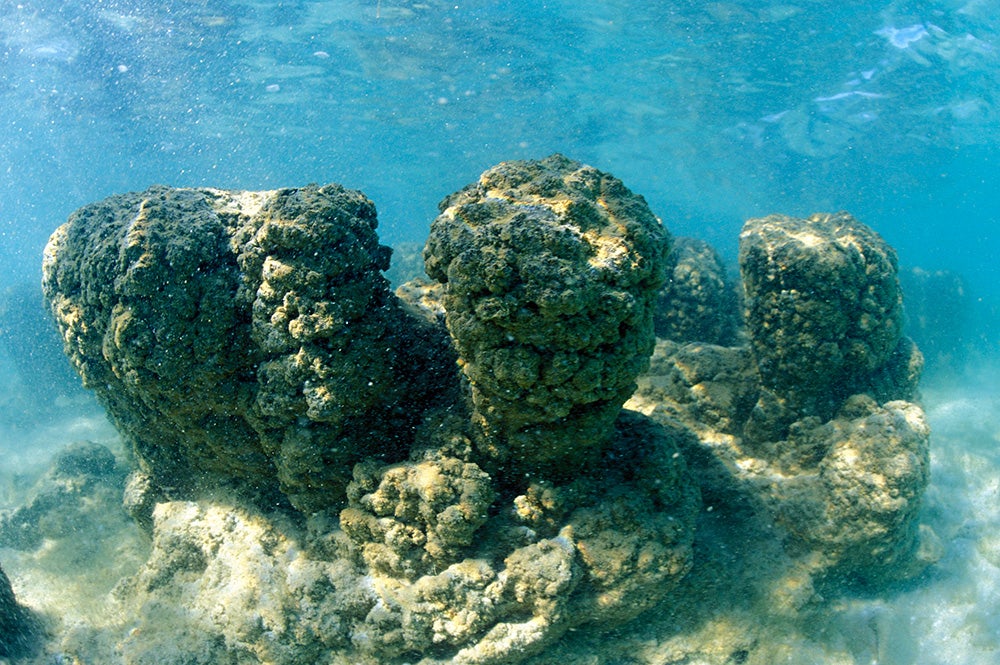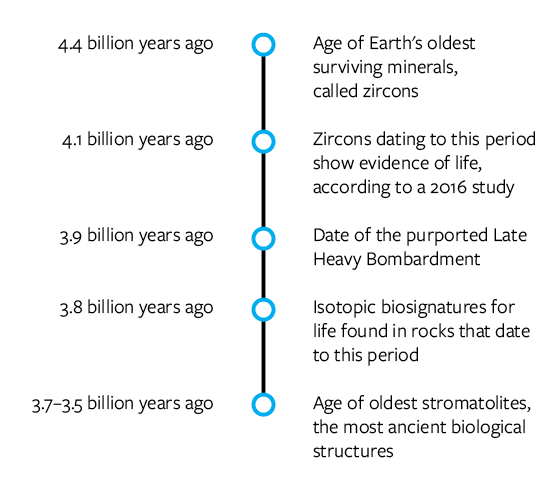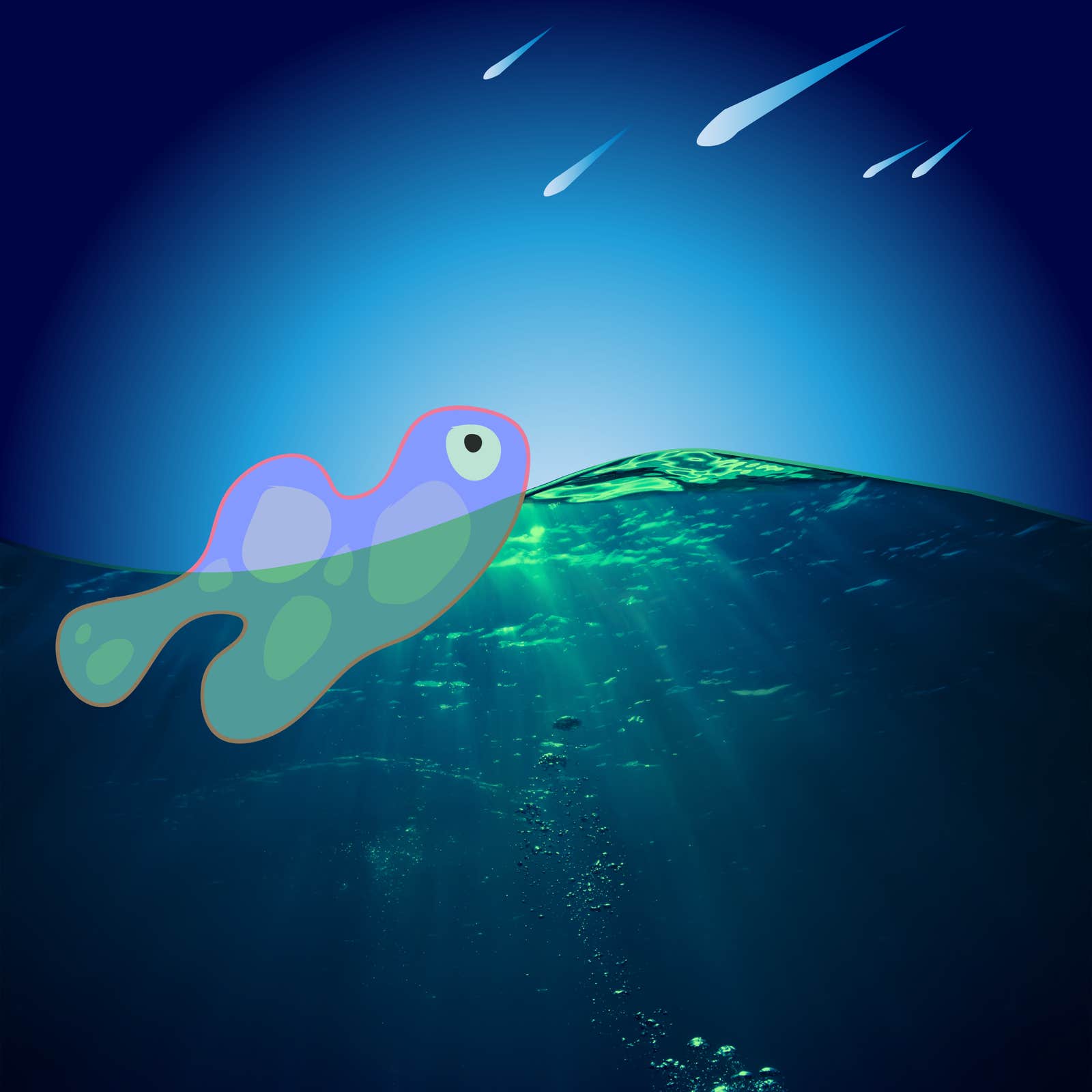Astrobiology isn’t exactly a data-rich science. We don’t know how many other lifeforms are out there or whether they exist at all, and we don’t even know where or how life on our own planet got started. But there is one question we should be able to get traction on: when life originated on Earth. And that one piece of knowledge would tell us a surprising lot.
It would tell us, to begin, the conditions under which life arose, helping us to predict where else we might find it. Moreover, it would clue us into whether the origin of life is an inherently unlikely event—a lucky roll of the organic chemical dice after hundreds of millions of years of trying—or a quick and all but certain consequence of wet planetary surfaces such as ours. If it took eons for the first microbe to appear in the geochemical muck, life must have been fairly hard to assemble and is likely a rarity in the universe; if it popped up shortly after Earth became habitable, then life would seem an inevitability, and the universe should teem with living things.

The two of us normally direct our attention upward; our own research is the study of exoplanets and the search for extraterrestrial intelligence. But our efforts are guided by what our paleontologist, geologist, and biologist colleagues have found about genesis on Earth. They have sought to box in the date on two sides: the earliest time our planet could have supported life, and the age of the oldest fossils or other organic detritus. Meteorites have been dated to around 4.5 billion years ago, which presumably marks the formation of the solar system and therefore of our planet. The oldest surviving minerals on Earth itself are zircon crystals from Western Australia dating to 4.4 billion years ago. Coming from the other direction, the most ancient biological structures on Earth are stromatolites, which are layered mounds that cyanobacteria erect in shallow waters. Geologists have dated fossil stromatolites, also from Western Australia, to 3.5 billion years ago, and this year they found others in Greenland that go back 3.7 billion years. Since cyanobacteria are a fairly complex form of life, there must have been a substantial period of evolution that stretched back even further. Isotopic signatures of life have been found in rocks as old as 3.8 billion years.
All these data are hard-won, and none has gone unchallenged. In the past few months, an intense debate has broken out over what has been arguably the single most influential discovery concerning the biological starting line.
In the final Apollo landings of the early 1970s, astronauts filled bags with rocks from lunar impact craters. In these samples, geologists measured the amount of argon, an element that is chemically foreign to the rock; it appears only because potassium was locked into the crystalline structure when the rock solidified and the potassium later decayed radioactively to argon. Because the decay occurs at a known rate, the relative amounts of argon and potassium provide an estimate of a rock’s age.
What the geologists found was surprising. Many of the rocks dated to a narrow range of time, between 4.1 and 3.9 billion years ago. Apparently, an unexpectedly high number of lunar impact craters, including some of the largest, were gouged out nearly all at once. The clear inference was that moon had suffered a massive bombardment by asteroids. And if the moon did, so did Earth.
A new analysis suggested that the bombardment may not have occurred at all.
Indeed, Earth must have had it worse, because it is a larger body and has a stronger gravitational pull. This cataclysm became known as the Late Heavy Bombardment—“late” because it occurred well after the planets had already taken shape and the rate of impact should have long since subsided. By some estimates, it was like having the equivalent of a dinosaur-killing impact once every few millennia, or even more frequently. The largest impacts would have turned most of the Earth’s surface into a sea of hot magma, and probably boiled off any water that had accumulated on the planet. No lifeform could have survived that. These events substantially narrowed the window over which life as we know it could have arisen: It couldn’t have gained a foothold before 3.9 billion years ago, but the isotopic and fossil records suggest it was already active by 3.8 billion years ago. On a geological time scale, genesis was practically instantaneous.

Many scientists were unconvinced. The samples represented only a small fraction of the moon’s surface, after all. Though collected from different locations, they might be ejecta from a single large impact, explaining their common ages. But a powerful argument in favor of the bombardment emerged in the early 2000s. Planetary scientists came to realize that the planets probably did not form in their current orbits, but migrated toward or away from the sun. An influential model of these perambulations, developed a decade ago by a team based in Nice, France, was able to reproduce the current positions of the planets. Along the way, the planets stirred up asteroids and flicked huge numbers of them into the inner solar system, creating exactly the bombardment the moon rocks indicated. Many doubters were finally persuaded by this elegant and well-justified model, and the Late Heavy Bombardment became textbook science.
This past September, Patrick Boehnke and T. Mark Harrison of UCLA published a paper that struck at the foundation of the bombardment scenario: the ages of the Apollo samples. They began with the fact that the argon isotope abundances used to date the Apollo samples are very sensitive to temperature. Even modest temperature increases of a few hundred kelvins can cause argon to diffuse out of the rock, effectively resetting the argon clock near the surface of the rock, at least partially. Such temperatures could be achieved by small, nearby meteoritic impacts that did not melt the rocks. They showed that multiple partial resettings could lead to the appearance of total resetting, making the samples appear much younger than they truly are. In that case, the measured isotope ratios in the Apollo samples no longer require a massive bombardment to make sense.
Boehnke and Harrison also did computer simulations of different possible impact histories for the moon to see whether the argon measurements truly required a Late Heavy Bombardment. They found that a smoothly declining impact rate would explain the isotope abundances just as well. In short, they argued that the original analyses of crater ages from the Apollo rocks overstated the case for a bombardment. Since these analyses formed the basis of the Late Heavy Bombardment hypothesis, Boehnke and Harrison’s new analysis suggested that the bombardment may not have occurred at all.
Other researchers have been studying the asteroid belt, since the asteroids would have been as much the victims as the perpetrators of the Late Heavy Bombardment. The evidence is equivocal. A key puzzle piece is Vesta, the second largest asteroid and the only one that has been conclusively linked to meteorites that have fallen to Earth. Julia A. Cartwright of Arizona State University and her colleagues have examined some of the Vestan meteorites. Embedded in these rocks are previously melted pebbles known as clasts, which the team dated to a narrow range of ages from 3.4 to 3.7 billion years ago. That suggests a cluster of impacts, in keeping with a Late Heavy Bombardment.
Earth might have been hospitable to life much earlier than we had assumed.
On the other hand, NASA’s Dawn mission visited Vesta in 2011 and 2012. Based on images of its surface, Simona Pirani of Lund University in Sweden and Diego Turrini of the Italian National Astrophysics Institute concluded that Vesta shows little indication of a bombardment. Few craters on the surface seem to date to this period; most are more recent, and Vesta has no atmosphere, oceans, or plate tectonics to wipe away evidence of previous impacts. Indeed, the supposed bombardment was so heavy that it should have ejected Vesta from the asteroid belt altogether, so the asteroid’s very existence seems to argue against such a cataclysm.

Meanwhile, many geologists and microbiologists have questioned whether the Late Heavy Bombardment, even if it really happened, would have been all that bad. Yuhito Shibaike and Shigeru Ida of the Tokyo Institute of Technology and Takanori Sasaki of Kyoto University have argued that the bombardment would have melted, at most, 70 percent of Earth’s surface. That is still a lot of surface, but it would have left refuges for life. A study by Norman Sleep of Stanford University and his colleagues argued that if life began on or spread to the ocean floor, then the primary concern would be the vaporization of the oceans. They showed that the canonical Late Heavy Bombardment impacts likely lacked the energy to boil that much water, and so would not have been able to sterilize the planet.
Further hints come from the ancient zircon crystals. Zircons require liquid water to form, so they, too, suggest the bombardment could not have completely remelted Earth’s surface and boiled off all surface water. So regardless of whether the earliest life clung to the land or hid beneath the waves, the bombardment may not provide a good limit on the starting point of life.
These findings have shocked some of us who work in astronomy, but as we talk to our geologist and microbiologist colleagues, we find that the findings merely reinforce the earlier misgivings about the bombardment. If Boehnke and Harrison are correct, where would this leave us in trying to understand the history of life on Earth?
If the early Earth did not go through a Late Heavy Bombardment, but instead suffered a slowly decreasing bombardment rate from its formation, it might have been hospitable to life much earlier than we had assumed—as long ago as 4.4 billion years. If life goes back 3.8 billion years, it may have taken hundreds of millions of years to arise, and that would imply life may be much rarer than we had thought.

But other evidence suggests that life is older than geologists and biologists previously recognized. In a separate study from their moon-rock takedown, Boehnke and Harrison, along with their colleagues, have argued that zircons show direct evidence of life 4.1 billion years ago. If so, we would be left with much the same conclusion as before: that life arose almost instantly on a geologic timescale. Since nature rarely gets things right on the first try, that implies that life spawns easily in the right environment and is probably common.
For now, though, the main result of the findings is to introduce new uncertainty into the science of astrobiology. For decades, the Late Heavy Bombardment has provided an important benchmark in our understanding of how, when, and where life formed and of how the solar system evolved from a chaotic swarm of planets and planetesimals to its current orderly configuration. If Boehnke and Harrison are correct, modelers of planetary evolution have fewer constraints within which to work.
The answers will help to determine how we conduct searches for extraterrestrial intelligence. If life forms quickly in favorable environments, then almost every planet or moon we discover in its star’s habitable zone has the potential to host life. On average, every star in the galaxy has one planet, so almost every star in the sky would be a search target. On the other hand, if the origin of life is a rare event, we should be focusing our limited telescope time on the oldest stars, where life would have had the most time to arise.
With so much in the balance, it’s clear that scientists need to take another look at the Apollo samples and figure out what they really tell us. Boehnke and Harrison suggest a series of steps: more quantitative analyses to construct a temperature chronology of the rock samples; in situ argon isotope dating of rocks by future lunar missions; careful selection of samples to ensure that they are truly representative of their surroundings; and more research into the properties of the impactors that created the lunar basins, to better understand how much material has struck the moon in total.
Until we do these things, the answer to when life began on Earth will remain further out of reach than we thought. Reevaluating foundational theories in science can be unsettling, but it ultimately strengthens our grasp of the universe.

























